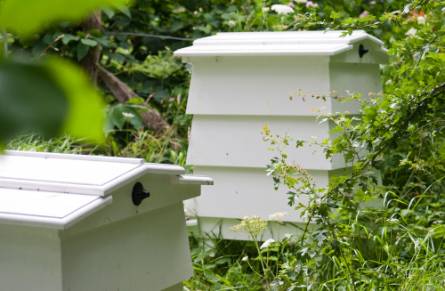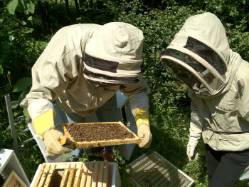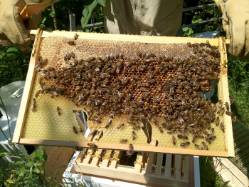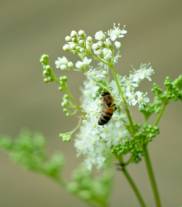'What bees hate is the three Ws,' says Luke Dixon, our garden's beehive manager. 'That's the Wet, Wind and Wintry weather!' ... 'Oh dear', I think to myself as I catch up with him on a recent visit to the Museum's Wildlife Garden.
There are about 40,000 bees living in each of the Museum's Wildlife Garden hives. Select photos to enlarge.
'It's been a poor year across Britain for the bee populations because of the summer rains,' Luke continues, 'but, our bees in the Wildlife Garden have been doing fantastically so far.'
I discover that each of our two bee hives near the garden shed (n.b. in the private bit of the garden) is currently home to about 30,000 to 40,000 bees. I'm not sure how they manage to count them, mind! And the Bee Tree by the meadow is bursting with about 50,000 to 60,000 this summer.
You can watch what our most industrious garden inhabitants are up to right now on our live beecam.
Inspecting the Museum's hives
'Here in the Wildlife Garden, it's sheltered and because of our different habitats, there is a lot for the bees to forage on,' explains Luke. I can see exactly what he means. As Caroline, the garden's manager, leads me up the path to investigate the Bee Tree we pass a mass of pretty wild flowers in the meadow and later I notice the flourishing heather on the heathland.
Irresistable wild flowers in the Wildlife Garden's meadows, one of the thriving habitats we cultivate.
The Bee Tree is certainly buzzing and full to almost bursting point with honey combs. It also appears that something has been trying to get into the honey treasure trove - sawdust on the bark's back door is a bit of a give-away. Caroline suspects a woodpecker.
For those who remember the 2010 Wildlife Garden honey, the news is they may collect honey from the bees in October, but it depends. 'We want to leave the bees some to eat in the winter months' says Luke, so we'll have to see.
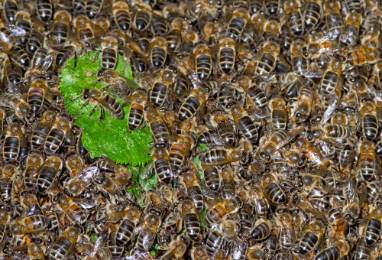 This amazing photo (left), taken by our Museum photograher, shows bees swarming in his garden. They sometimes do this in late Spring and, for the first time in the eight years that we've kept them, the bees of the Museum's hives did so in the Wildlife Garden last week! I asked Qais Zacharia, who also looks after the Museum's hives, why this occurs:
This amazing photo (left), taken by our Museum photograher, shows bees swarming in his garden. They sometimes do this in late Spring and, for the first time in the eight years that we've kept them, the bees of the Museum's hives did so in the Wildlife Garden last week! I asked Qais Zacharia, who also looks after the Museum's hives, why this occurs:
'This is slightly unusual for this late in the year, but could be due to the poor start to the summer. Swarms form when the colony becomes overcrowded; the queen leaves and approximately one third of the bees from the colony follow her in search of a new home. The remaining bees stay behind to rear a new, replacement queen.
'During the swarm tens of thousands of honeybees can take to the air and, despite appearances and terrible B-movies, they are not agressive (their principal focus is finding a new home). After leaving the old colony, the swarm will typically congregate on a nearby branch while scouts search for a suitable place to form their new colony, a process that can take as long as a few days.
'Experienced beekeepers are able to capture the swarm at this point - assuming it is within reach - by shaking the bees into a "nucleus box" before moving them into a new hive. However, we didn't manage to do this last week as the swarms were too high up in the trees and they must have made a new home elsewhere, which could be anywhere from somewhere close by to several miles away.
'At the old colony, the new queen will hatch after about a week and will venture out to mate with drones from colonies nearby before returning to lay eggs. A good sign that a queen has successfully mated is pollen being taken into the hive but, if mating wasn't successful, the colony will dwindle and eventually die off. This can be prevented in kept hives by swapping in a specially bred and mated queen for the unsuccessful original.'
If you're visiting the Museum in summer, drop into the Wildlife Garden. And look out for a 'living' bee sculpture by artist Tomàš Libertíny outside the Museum between 28 July and 5 August as part of the Exhibition Road Show.
Enjoy our Wildlife in summer website
Find out about visiting the Wildlife Garden
Browse the Wildlife Garden highlights slideshow



